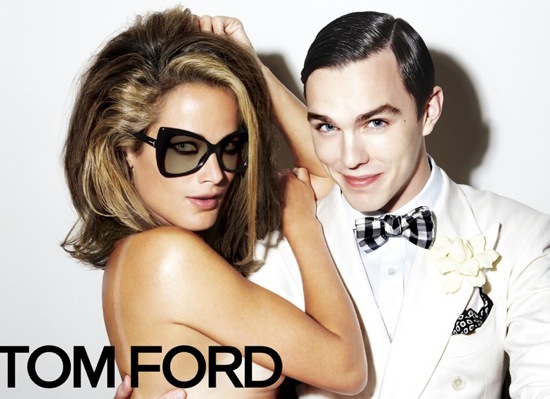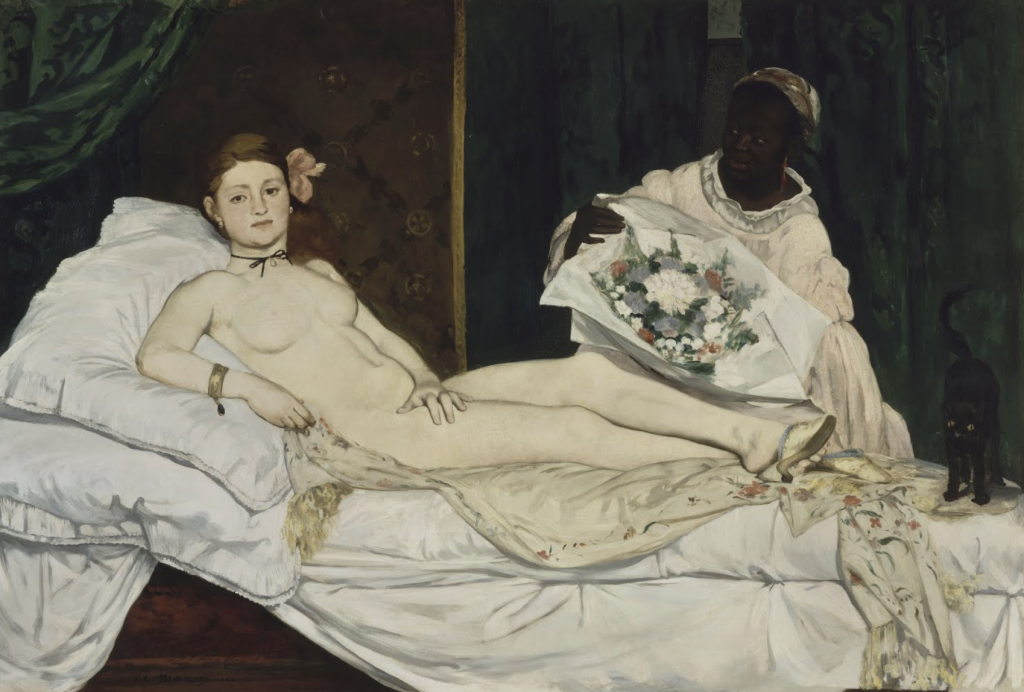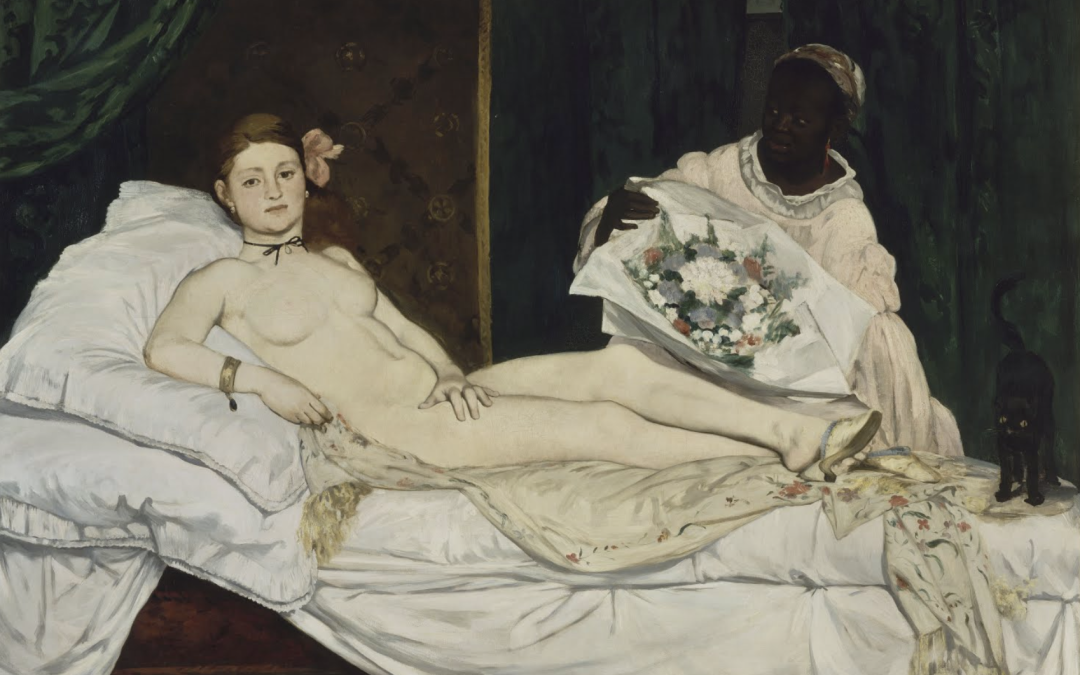Marketing in the fashion industry can be seen all over the world, on social media, billboards, magazines, and more. With the craze surrounding the newest trends and collections, the industry holds power and influence like no one else. So, how is it that there are still so many issues with using the over-sexualisation of women to hike sales?
‘The Male Gaze Theory’ – Laura Mulvey
‘Olympia’, Manet – A discussion of visual culture
#MoreWomen – Discrimination of women at the top
Pride and Prejudice – Stereotypes used in fashion marketing practices
The End – How we can put a stop to the over-sexualisation of women in the media
‘The Male Gaze Theory’ – Laura Mulvey
Laura Mulvey published the ground-breaking ‘Visual Pleasure and Narrative Cinema’ in 1989, in which we are faced with the first instance of the ‘Male Gaze’ Theory, a concept many were not ready for at the time of its release. The theory, in its essence, states that women are depicted from a heterosexual male point of view. They are portrayed as sexual objects for the pleasure of male viewers. In media (e.g. film, literature, art. etc) women are subjected to seeing other women depicted as nothing more than an object to be admired; dehumanising and objectifying them based on their beauty and sex appeal [1]. The ‘Male Gaze’ theory can be found throughout countless fashion campaigns, including, but not limited to:
- Tom Ford
- Boohoo
- Fashionova
- American Apparel
- Dolce & Gabbana
Nude women often placed with fully clothed men show the use of the male gaze to create a pleasurable viewing experience for male consumers, whilst expecting female consumers to desire the effect produced by the scantily clad woman. For example, the image below from a Tom Ford campaign shows clear intent to place the focus on the female in a sexual manner, despite the campaign being aimed at men’s glasses, making the requirement for nudity or sexuality void and irrelevant to the image.

The Male Gaze Theory is seen far more often than we would initially expect in all types of media, specifically film, music, and fashion communications.
‘Olympia’, Manet – A discussion of visual culture
To see the Male Gaze in action outside of the fashion context, the classic painting, ‘Olympia’ is an exceptional example. ‘Olympia’ – created in 1863 by Édouard Manet – was a rebellious piece of artwork during its time. It was negatively received by its audience due to it lacking the elevation of classical art [3], taken as a mockery of traditional nude art. One of the main points in ‘Olympia’, is that the woman in the image is not depicted as doing anything. Whilst many nude paintings of the time had women bathing or dressing, etc. Manet left ‘Olympia’ doing nothing. Simply staring into the viewers’ eyes; not suggestively, simply looking. This was strikingly contrasting to the demure nude women in paintings during the 1800s, shying away from their painter, and their eventual audience. Manet often experimented with the subject of his paintings looking directly at the viewer, however, ‘Olympia’ was different, as it acted as a confrontation to the audience. Male viewers were often used to viewing women in art as objects of attraction. However, ‘Olympia’ is nothing to be attracted to. Instead, she confronts the male viewer and turns him into the one being viewed as an object of attraction.

#MoreWomen – Discrimination of women at the top
With cultural references dating back to the 1800s and further, the question remains, ‘is there space in our evolving global culture for sexualised marketing techniques?’.
Women are facing gross inequity in the workplace, specifically in politics and senior positions. There is not only a lack of women in these positions but they are scrutinised to a much higher degree than their male counterparts. The video below produced by Elle puts this into perspective.
To further put into perspective the unequal environment, only ’24.3% of all national parliamentarians were women’ in June 2019 [4] and just 21% of C-Suite positions were held by women according to the McKinsey ‘Women in the Workplace‘ Report for 2020 [5].
So, what does this have to do with sexualised marketing? It may not inherently cause these issues, but it does play into them. With business fashion being hyper-sexualised in the women’s department, it perpetuates the idea that women are less capable, and an object of desire, as Laura Mulvey discussed in the Male Gaze Theory.
Pride and Prejudice – Stereotypes used in fashion marketing practices
Aside from business fashion, many other niches in fashion marketing use this technique, from everyday wear, resort and loungewear, down to children’s wear, with girl’s clothing often being shorter, tighter and more expensive than boy’s clothing. This extends the stereotype past adults, starting the prejudice and ‘Pink Tax’ from a very young age.
Alongside this, nudity of women in marketing is used commonly to attract both male and female consumers. About a decade ago, this manifested heavily in online and offline storefronts, billboards, and magazines. However, with social media taking over marketing, it has been moved into this space. The use of nudity and near-nudity on social media is past just company posts but has moved into the influencer space. Influencers portray the consumer within marketing, in which brands will request certain styles of posts in exchange for items or pay. There are many brands that request sexually charges or scantily clad posts to portray the business in that light. However, this can sometimes backfire, with children as young as 13 allowed on most platforms, not to mention those lying about their age. Whilst censoring is not the answer, a consideration of what is being posted, and whether it is truly relevant to the product should come into play.
On the other side, we can see a double standard for women in higher-up positions, for example, female politicians are often scrutinised for what they wear, with the public, press and even certain brands, publishing extremely opinionated and often sexist remarks regarding their appearance, with a lack of regard for anything they are speaking on or producing. This can be seen specifically in the Daily Mail, The Sun and many more press publications, as well as within the comment section of these posts from the public.
The End – How we can put a stop to the over-sexualisation of women in the media
So, how can we change the situation, and remove sexist messaging from the fashion media industry? Removing nudity, near nudity and introducing censoring will not work, and will most likely make the situation worse. The key is in how women are portrayed in fashion media and how relevant nudity or sexualisation is to the brand message.
For example, Dove is a positive example of using near nudity in their campaigns to normalise different body shapes, types, and sizes. It is relevant being that they are a skincare and shower product company, and, most importantly, the women in the campaigns were not being sexualised, but were more so existing happily in their own skin.
This is a vastly different experience, for example, to American Apparel, which created campaigns of girls in an extremely sexual manner, with insinuations taking over any other messaging. Whilst they were wearing more clothing than in the Dove campaign, it was still far more inappropriate and didn’t relate to the brand itself. This is a prime example of over-sexualisation hindering women and their rights to be taken seriously in all aspects of life, specifically in the professional world.
Following the footsteps of those brands portraying women in a positive light, through liberation and acceptance, fashion, press and more could further the feminist movement, rather than hindering it through sexist visuals and remarks. Consumers can encourage this behaviour by engaging with brands that show a positive side to marketing and media involving women, whilst avoiding those that do not.
To answer the question, Are Fashion Marketing Practices Hindering the Feminist Movement? Yes. But it does not have to be that way. Learning from past mistakes, actively avoiding the Male Gaze, specifically in women’s media, and unlearning misogynistic actions towards women in the workplace are the pillars for changing the answer to ‘No’. As these mindsets change and become more female-forward, we can expect fashion brands and media to follow suit.
Links
[1] http://https://www.amherst.edu/system/files/media/1021/Laura%2520Mulvey,%2520Visual%2520Pleasure.pdf
[2] https://www.mindlessmag.com/post/is-there-a-place-for-sexualised-fashion-advertising-in-2020
[3] https://www.khanacademy.org/humanities/becoming-modern/avant-garde-france/realism/a/manet-olympia
[4] https://www.unwomen.org/en/what-we-do/leadership-and-political-participation/facts-and-figures
[5] https://www.mckinsey.com/featured-insights/diversity-and-inclusion/women-in-the-workplace#


Your blog post offers much food for thought! I feel like we generally tend to bypass the stereotyped and over-sexualised representation of women in media. It seems like we are somehow accustomed to these practices, which demonstrates how far we still are from reaching gender equality and a more respectful depiction of women in any field. However, as you pointed out, we are moving in the right direction as many brands like Dove are now committing to portraying women with dignity, in the wake of the #MeToo movement. So there is definitely hope for change.
I totally agree that we are completely accustomed! Hopefully as more people are aware and understand the harm these practices can cause, we will see even greater change.
Watching the evolution of the male gaze theory within art through to modern day fashion communication is an interesting topic. One for brands to watch out for in the future.
I completely agree, one to watch out for in future brand marketing endeavours.
This is a very interesting blog that men and women should read! The move to the right direction is very hopeful. Fashion and Media should really help the Feminist Movement!
I agree, it is looking more and more hopeful.
An interesting deep dive in to how sexualisation of women in art and culture is represented through fashion media. Hopefully, we will soon see even more brands move on from this style of marketing.
Thank you and I absolutely agree, hopefully, more brands will begin to understand that it causes more harm than good.
Excellent read! Something that I was aware of but seeng your example about Tom Ford really hit home. We’re so used to it that it doesn’t even stand out anymore. When you were talking about stereotypes in the fashion industry I thought of that video where a mother went into different clothing shops (I believe it may have been supermarkets) and showed the different slogans on girls clothing versus boys clothing. It was shocking. The boys clothing were positive, encouraging and empowering. While the girls clothing displayed messages like “princess”, “stay at home” and “little cutie”.
Thank you! Your example is proof that it starts from so young and is so ingrained into our society. Now time to hold out hope for future marketing endeavours in the fashion industry and further.
I enjoyed reading your post! I liked that you used the classic painting as an example in addition to the recent marketing campaigns for illustration.
Thank you! I find that many of our practices today can be seen in art and culture much before our time. It is a very interesting comparison.
An excellent piece of writing. I think I’m so normalised to seeing women sexualised in marketing because of Hollywood. Wow, this is a lot to reflect!